We all know the importance of keeping plenty of food on hand to get us through a crisis. Stockpiling food is usually the first thing that any of us do as preppers – and it’s something that we keep on doing, long after many of our other preps are in place. But having food and having a way to cook it are two different things. Without the ability to cook it, much of that food will be worthless.
Of course we all have cookware in our homes, as well as barbecue grilles, fire pits and other places to cook. But what if we have to bug out? I carry a complete set of backpacking cookware in my bug out bag, but I see an awful lot of lists which don’t include that. Rather, it seems that there are a lot of people around who think a couple of pieces of aluminum foil is all the cookware they’re going to need.
Well, I’ve cooked in aluminum foil. It works. At least, it works the first couple of times. Then the foil gets ruined and you don’t have anything to cook that tasty packet of ramen in. What are you going to do then?
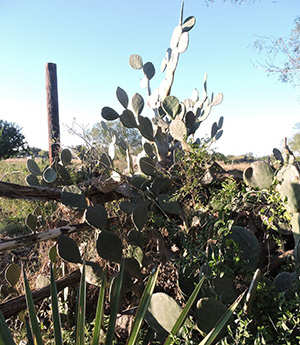 One option is to make a cup out of birch bark and cook in it. Of course, that presumes that you’re in a part of the country where birch trees grow. If you’re not – say for example, you’re in the Southwest – then that isn’t going to work. You’ll need another option; an option like cooking in a cactus.
One option is to make a cup out of birch bark and cook in it. Of course, that presumes that you’re in a part of the country where birch trees grow. If you’re not – say for example, you’re in the Southwest – then that isn’t going to work. You’ll need another option; an option like cooking in a cactus.
One of the most common cacti around is the prickly pear. I’m not sure how many different varieties of prickly pear there are, but there are 18 of them growing in the Sonora Desert alone. Some varieties provide the tuna fruit and others are eaten as a vegetable in Mexico, known as “nopal.” While not common in the United States, nopal has been widely recognized by the health food industry for its many excellent properties.
Since the prickly pear is edible, there is no problem using it to heat water for making coffee or cooking your packet of ramen. For that matter, once you cook it, you could scoop the inside of the pad out and eat it as well. While it might not taste like your favorite vegetable, it will provide you with some nutrition.
Prickly pear leaves or “pads” come in a variety of sizes, depending on the particular type of prickly pear plant. Most have spines, but there are a few varieties, especially the nopal, which do not. I was fortunate enough to find one with only small spines to use for my experimenting with this method.
Preparing the Cactus
You’re going to need one large prickly pear pad to use as a cooking vessel. Make sure that it is an unblemished pad, without scars and especially without any holes in it. There is no real way to patch any holes, so if you harvest one with holes or put any holes in it, in the process of preparing it, you’re going to have to start over.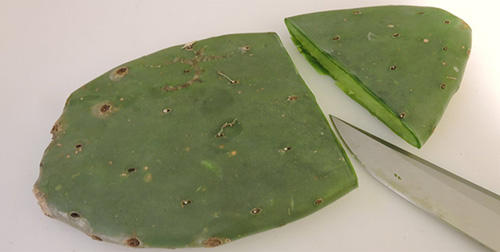 You can cut the pad at the joint, where it connects with the next pad, but if you do this, you’ll need to cut the pad again, to make the opening for the top of your cooking pot. It works better to just cut across the pad, where it is getting close to its maximum width, providing you with that opening.
You can cut the pad at the joint, where it connects with the next pad, but if you do this, you’ll need to cut the pad again, to make the opening for the top of your cooking pot. It works better to just cut across the pad, where it is getting close to its maximum width, providing you with that opening.
The next thing you’ll want to do is singe the spines, so that they do not stick you. Be especially careful to singe the smaller spines, as they are usually sharper and harder to see and remove. You probably won’t be able to burn the larger spines off all the way, without running the risk of putting a hole in the pad. But if you can at least singe off the point, it won’t be able to stick you.
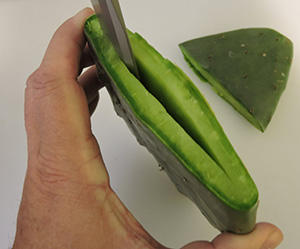 If you cut the pad off at the joint, rather than cutting a top, you’ll need to cut it off now, making the opening at the top of your cooking vessel. Then you’ll need to carefully stick your knife down in the middle of the pad, creating a slit so that it can be opened. It is extremely easy to put the point of your knife through the side of the pad at this point, rendering it useless and forcing you to start over, so you need to be extremely careful, cutting a little bit at a time.
If you cut the pad off at the joint, rather than cutting a top, you’ll need to cut it off now, making the opening at the top of your cooking vessel. Then you’ll need to carefully stick your knife down in the middle of the pad, creating a slit so that it can be opened. It is extremely easy to put the point of your knife through the side of the pad at this point, rendering it useless and forcing you to start over, so you need to be extremely careful, cutting a little bit at a time.
The pad will be stiff, so it will not be easy to open it up and make a vessel out of it; but if you wedge it in the fork of a stick, you can force it open slightly. This will also allow you a stand to hold the pad upright as you are cooking in it.
Related: How to Cook without Alluring Smells
Cooking Your Ramen
With the cactus pad now prepared, you are ready to start cooking. Ramen are cooked in boiling water, so the idea is to fill the cactus pad with water and then to get that water boiling.
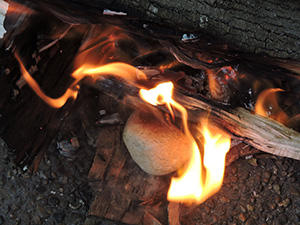 If we were working with that birch bark cup, we could put it over the fire. As long as the flames don’t reach higher than the water level in the cup, it will not burn. I’m not sure if this will work the same way with the prickly pear pad, as I’ve never tried it. Rather than do that, we are going to put hot rocks inside the water to heat it up.
If we were working with that birch bark cup, we could put it over the fire. As long as the flames don’t reach higher than the water level in the cup, it will not burn. I’m not sure if this will work the same way with the prickly pear pad, as I’ve never tried it. Rather than do that, we are going to put hot rocks inside the water to heat it up.
This, of course, requires a fire, which is the first thing we should have done before hunting up our cactus leaf. A larger fire is not needed, but it does need to produce some good coals, as the coals are the hottest part of the fire. We’ll need to put some small, preferably smooth, rocks in those coals to heat them.
It’s important that you use stones which don’t have any cracks or fissures in them. If they do, there will be a chance that there will be water in those cracks. When heated, that water will expand and might cause the rock to break or even explode, scattering pieces all over the place. Better to avoid that, by not using stones with cracks in them. Stones that you gather from a stream bed are fine, just as long as you check them for cracks.
A couple of sticks can be used as “tongs” to pick the rocks up out of the fire and put them in the cactus pad to heat the water and bring it to a boil. You will probably only be able to use one rock at a time, allowing its heat to transfer to the water in the cactus. Once it has transferred (after 20 to 30 seconds) remove it and replace it with another stone. Repeat this until the water is at a boil.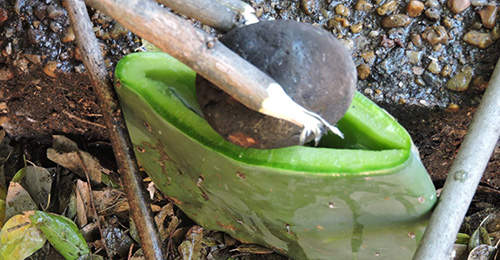 At this point, you’re going to be glad that you have a couple of sticks holding your cactus pad up, as the boiling water inside it will make the pad hot and difficult to hold.
At this point, you’re going to be glad that you have a couple of sticks holding your cactus pad up, as the boiling water inside it will make the pad hot and difficult to hold.
With the water boiling, you can now break up your ramen and put it and the seasonings in the cactus pad to cook. You’ll probably only be able to fit about half a pack at a time, but the water can always be reheated to cook the remainder. Ramen cooks quickly, so you’ll be able to eat it within a few minutes after putting it in the water.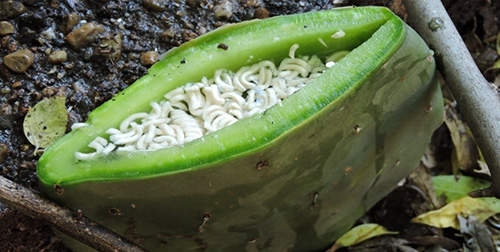 If you are adding any dry ingredients, such as dried vegetables or cut up jerky to your ramen, to turn it into a heartier soup, be sure to add them before the ramen, as they will need more time to soften in the hot water. Even so, those additional ingredients might be a bit chewy, but at least they will be edible.
If you are adding any dry ingredients, such as dried vegetables or cut up jerky to your ramen, to turn it into a heartier soup, be sure to add them before the ramen, as they will need more time to soften in the hot water. Even so, those additional ingredients might be a bit chewy, but at least they will be edible.
Speaking of being edible, if you don’t have a fork or spork in your survival gear, you can always use the time while you are waiting for the water to boil to whittle yourself a pair of chopsticks. That’s the right way to eat ramen anyway, isn’t it?
You may also like:
 11 Food Storage Lessons Learned from WWI
11 Food Storage Lessons Learned from WWI
What Happens If You Add Honey To A Coconut (Video)
7 Primitive Cooking Methods You Still Need to Know Today
The Lost Art of Scratch Cooking
If you liked or article don’t forget to pin it!
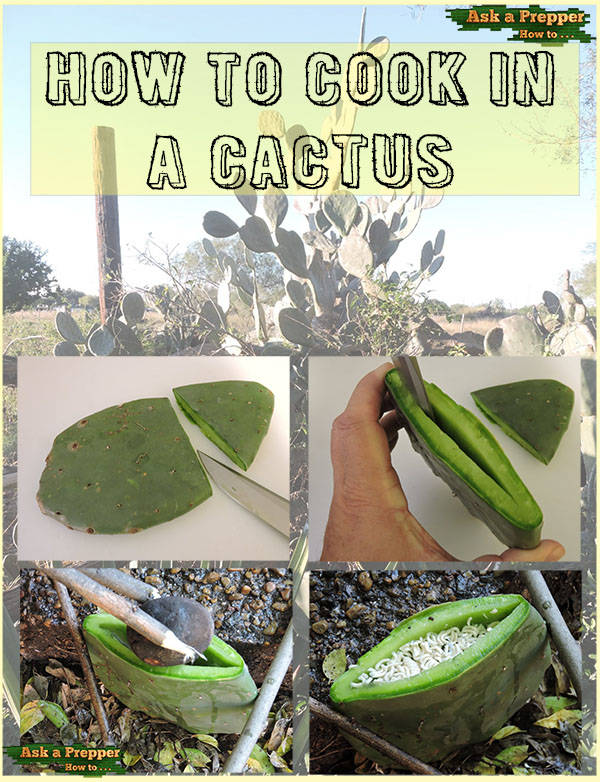

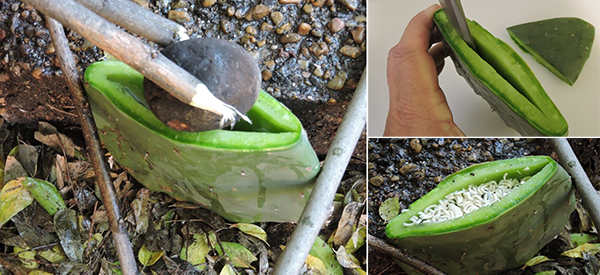













Unless you are stuck in a desert, this is completely useless.
First, the author pointed out that you needed to be in the Southwest. Second, you obviously don’t know where all prickly pear cactus grows. Aside from more desert regions, they grow up into the Great Plains, the Rocky Mountains, east into Florida and up the East Coast to Connecticut.
Fair point
You forgot the Cactus curtain in Cuba. A sister-in-law in Ohio raised a native ‘pear for the fruit. While native there, they’re now very rare. I live in Arizona and we have a thornfree variety from Mexico bred for nopalito production. It still has a few thorns, but small one, glochids. BIG pads, that are easy to prep, and the fruit is almost twice the size as wild fruit and sweeter. Only thing, no thorns mean deer and rabbits will eat it (not to mention greedy cattle and horses), and birds will pick out the end of the fruit, even thorny wild ‘pears, to get at the seeds. Early last summer, we had a hail storm that punched a hole in the rear window of a Mustang, and tore holes in the pads. Birds and rabbits went nuts, eating the pads.
Spain took pads and spread them to Europe and the mediteranian region. They were used as food and safe fences.
The two banes of Australia, prickly pear and our beloved tree of life, mesquite. I have a half-dozen honey mesquite coming up in the yard, and will let them grow. Light, airy shade, good eating, and a defence in the food-forest. They provide a lot of nitrogen and come summer, chiltepins will be planted around the big one. Niio..
cool….. it’s still a good article
Not so true, I live in Arkansas and there are several places to get them around. At least until a hard frost hits them. They always come back tho and are kind on the small size. I believe you could probably use two or three and fix up a descent bit to eat.
Do you eat yucca root? One is the potato type seen in stores. Roasted, taste like burned dirt (they do that when making mescal), but boiled, tastes like chestnuts. Makes great noddles if you add 1/3 starch and drop in boiling water. the other is soap root, and using the root to wash with will heal a lot of skin disorders. A type of soap root is called datil (date), and is cleaned and cooked (stuffed, coated, deep-fried). Cooking destroys the saponin, which is somewhat toxic. I also have soap root and banana yucca. The fruit is something like a squash.
Native tribe where I live use the large fruits from yucca as a desert. Simply roast with bread baking in the outdoor horno or Adobe oven. It is smooth and flavor can be reminiscent of banana pudding. At my last home there was an area with almost 100 yucca plants with the larger fruits. I wish I’d dug a few to move with us.
Banana yucca. Good eating. The green fruit on soap yucca is datil. Split, clean, stuff, coat and deep-fry. BTW, take the seeds from the banana fruits and put on barren sand, cover with a little soil.
Tun (prickly pear) grows from the low desert to Alberta, east into Ohio, south to Cuba and the Amazon. Have you never heard of the Cactus Curtain in Cuba? Prickly pear that will grow in a swamp.I live in AZ Central and we prefer to cook these in fried food, stews, and any way you like. Pickled or fresh, they’re good. But, never eat them raw or you’ll find they’re much, much better than prunes or even ex-lax 🙂
Not useless to me. I do live in the desert Southwest
Believe it or not, some of us DO live in the desert, and have prickly pears all over. This was useful for me.
Do not touch fruit, crush in food processor, simmer, strain out the thorns and seeds. To use juice, 5 cups water, half-cup juice, tastes like watermelon. The nopales, wow. I was too sick to pick any this summer, but next year, I want to fill a crock and pickle them with cilantro, onions, and chilis. Hey, a neighbor gave me some ruby grapefruit for hailing off piles of dead weeds and grass./mulch. I need as much as I can get, and here she wanted to pay me to take it. Another one gave me a bushel of peaces for helping haul off more mulch. I keep telling folks, I need the mulch but they insist. niio
As much moisture as is in a prickly pear pad, I would think you could set it in or over a fire rather than do the hot rock thing, though that seems a good way too. Putting it over or in a fire would probably add a bit of extra flavor from the cactus pad itself.
This is a great tip something I will recommend to a friend. Thanks
This post is a good example of why I enjoy Ask A Prepper. Cook in a cactus pad? That’s new to me! Will I ever do this? I doubt it. But, the idea has been planted. That’s what’s important.
And I hope I am never so desperate that I have to resort to using a cactus pad as a cooking utensil. Note to self: Always make sure the WWII canteen cup is somewhere in the car when traveling.
Nopales are okay for eating but they fall in the category of using corn husks for barbecuing. Thinking about it, I think corn husks are better.
What do you mean by using corn husks for barbecuing? Burning the corn husks for fuel??? I’d think the cobs would do better.
I do leave the husks on the corn when I throw them on the grill. It holds the juices in quite nicely and they seem tastier that way…no butter needed…plus pulling back the husks, but leaving them on gives you a nice handle for holding the corn. The kids really love that.
Use wet corn husks as you would aluminum foil
Soak dry corn husks or use fresh ones.Make corn dough and use that to coat the inside. Pack with sausage, tie it up and grill for toasted tamales. Been done for thousands of years, and is ‘way more common than the steamed ones in stores.We never took canned crap when out a week working cattle, nor do the old boys herding goats. You might be gone from home for weeks, but corn four lasts quite a while. It’s pre-cooked, and just add water to make the dough. Corn dough with sugar and spices in it for breakfast. That gets toasted, and is great.
My kids loved sweet tomallies. Brown sugar and rasins with a bit of cinnamon in that corn masa in damp corn husk. Same masa and corn husk filled with a meat and chili filling is as good hot as cold. Great meal or snack food.
The inner part of the prickly pear cactus can be used as a poultice for bites abscess infection.
If possible, toast it, first. Burn off the spines. Skinning won’t remove all the hair-like thorns. Split it and toast. It brings out that special quality, a gooy slime that’s loaded with all sort of things good for you. https://www.medicalnewstoday.com/articles/320293.php
I find this website rather fascinating.
However very frequently I find you falling back on situations that won’t exist if we must truly resort to primitive survival. Case in point: society has fallen apart. You don’t even have a pot to cook in. WHERE IN THE WORLD WILL YOU GET YOUR CUTE LITTLE PACKAGE OF RAMEN?
Get real people. You won’t have it. Don’t give us methods that are unrealistic.
If you are in a situation where you must resort to cooking in a cactus pad, you probably won’t HAVE any ramen or coffee. Sear the spines and tiny stickers off that cactus pad, roast it and EAT it. It may not be that tasty but it might help you survive.
Otherwise, go ahead and play primitive… Too many of these ideas are for weekend rougher, not logical for actual survival.
Honchess: Right after you finish the ramen, you scarf down the insides of the cactus pad that you have cooked the ramen in. Win-win situation. You get the noodles and the salt in the ramen and you get the vitamin C in the nopale and the roughage. PS: Be sure you have really burnt all the thorns off before eating. The only thing you are lacking is the protein. You look for cactus grubs and you can eat them raw. Voila! A well-balanced complete meal.
You forgot to add, a cup or two of tequila prior to eating the grubs helps them down the gullet. Probably the best way is, of course, toast them over a smoky fire, baste with tequila (stay away from cascabel de vaca, it’s 200 proof rotgut and will burn too fast to make a good baste). When toasted, clean the grubs discarding heads and legs, eat. Yummy. Taste like burned grubs with a nice smoky aftertaste. Then consume another cup of tequila.
Lol. Red. I’ll take the booze to wash down the grubs. 🙂
Actually a rabbit leg cooked and meat stripped off the bones then stuff the nopal pad. Burn off all stickers before handling much. Then roast the pad on a flat rock set in the middle of the fire with the meat in it. When it turns color and is tender the pad is done. Let it cool then eat like a sandwich. Great finger food and real survival or camping food. I actually do these on a piece of expanded metal over the fire and coals in my homemade bbq.
I have stashes of supplies in coffee cans on the mountain. A small cookpot, or pasta sauce cans, a piece of metal to cook on could all be hidden together.
I have two types of prickly pears growing along a fence line. I eat pads, fruit, make jelly, drink juice and make a gallon of wine each year. The ramen idea isn’t bad but I like finding foods that I could also make on the run. Doves, rabbits, ducks, slices of elk or venison could all be cooking in a pad or reheated in a pad as it cooks. Actually it’s mighty fine eating. The pad at the stage where the spines are still rubbery is the best flavored and most tender. I like one cooked on the bbq and laid in my hamburger but I don’t expect to have burgers and buns if I’m on the run in the mountains. Actuually at 72 and a husband with dementia I’ll bug in and take my chances.
I raise rabbits , chickens, and ducks. I make survival recipes using them. Actually they are good eating anyway. I’d bet we could cook scrambled eggs or the makings of a good omlet in some pads.
Our ‘pears all got eaten by doves and so on. They sat on each ‘pear and picked out all the seeds. We have the wild tun and domesticated tun. The domesticated has very few thorns and the pads are a lot larger than the wild uns. Oh, yeah, and that waste, Santa Rita prickly pear. Small, woody pads and the fruit gets an inch across, then withers.My dachshund is turning parts of the yard (natural desert landscape/sand and rock 🙂 into a mine field. He’s determined to tunel his way to a feast of ground squirrels. Better him than rattlers. At least now i have places to bury his nasty, and the squirrels hate that 🙂
Make the omelet and pour into a heated pad. It’s not as good as pan-fried, but you get toasted nopalito, as well. Nopalitos are a great veggie that combine well with most things.WalMart sells quarts for a buck-79, and we were paying almost 4 for the same thing when in Penna. Niio!
I’m working on planting prickly pear cactus along just over 400 ft of property line fence along a dirt road. About 1/3 is planted. As they grow new pads I’ll cut pads and plant more. I want cactus as a deterant to guys climbing through the fence. It’s both a security measure and a food source. And I really love cactus syrup on my home made pancakes. The fruit juice is an expensive natural medicine in parts of the middle east. Tasty, healthy, and an incredible color. Jelly looks like a jewel in a glass jar. Juice and wine have that same beautiful deep magenta color.
‘Pear juice is medicinal, yep. We’ve been using it for thousands of years, here. The water from the pads is antiseptic and more. http://cms.herbalgram.org/heg/volume12/09September/FaMPricklyPear.html?utm_source=hootsuite&ts=1547917148&signature=8b3cded1f0380d7bf9362fe4048fbe85
I knew an older lady down on the border who had a serious problem with mojados (wetbacks) raiding her ‘hood. She took some advice and planted nopale all along her back fence and a year later, screams woke up dogs all over town. No more raiders, at least on Mami’s property. Cholla is better. People fear it, and for good reason, and the Christmas cholla makes a good fruit. But, nothing beats ‘pears for visual effect as a deterrent 🙂 I’m doing garden trenches to get out the caliche and pile a lot of that outside the fence to stop the closet gays (arrogant people who like to damage someone’s property for fun, not necessarily gays). So far, they tried once to run into a steel post and lost a mirror off their truck 🙂
I live in Michigan so no use… still good to be informed about
In Ohio, one sister-in-law has native prairie prickly pear growing under the 1st floor windows of the farm house. Small yellow fruit, and the spring pads make nopalitos. https://trekohio.com/2013/07/03/a-native-cactus-of-ohio/ and https://michiganflora.net/species.aspx?id=691 One for you, though I doubt you’d want to. We can walk out back and find acres of cactus, and that makes them a food source. In Michigan, you probably have things that work better and taste better to you. A hedge of Rugosa roses can turn hogs and deer, let alone people. They like it damp, and love the summer heat in the East, as well. They’ve been found growing wild on cliffs in Labrador, and thriving near abandoned houses in Montana. People use the petals in herbals (for bruises and so on), and the hips a big, with a high amount of C. niio
Our neighbors have prickly pears growing out of small rock piles at the corners or their property, but they don’t look like they are doing all that well. They are in heavy shade under trees and bushes. When I was traveling out west with my sister, we saw the same type in full sun, looked much healthier. Also have them in other parts of town, in full sun, looking nice. Definitely long spines!! I have been tempted to cut a pad or two, just to sample. lol!
I live in southern Wisconsin! I have one growing in a sunny patch in my front yard, as does a friend of mine.